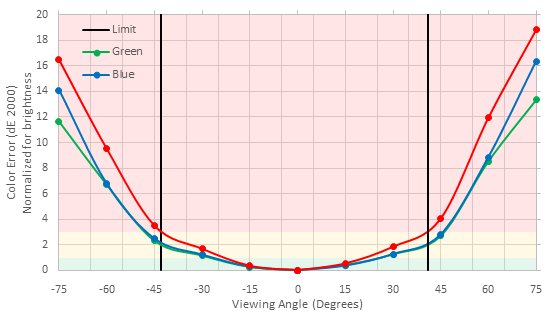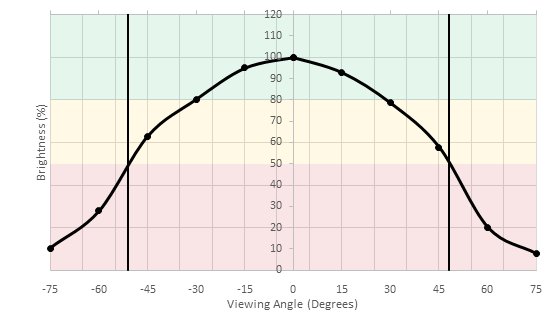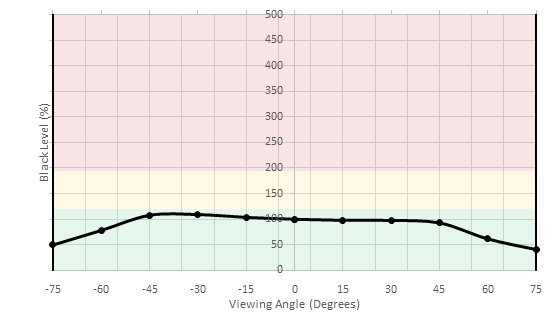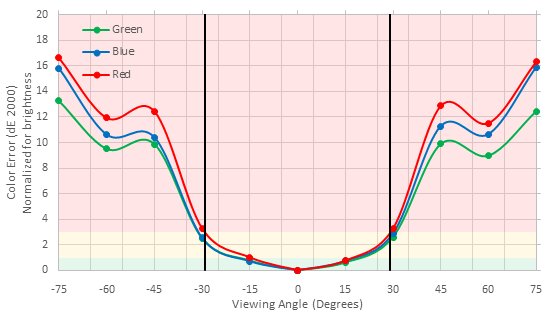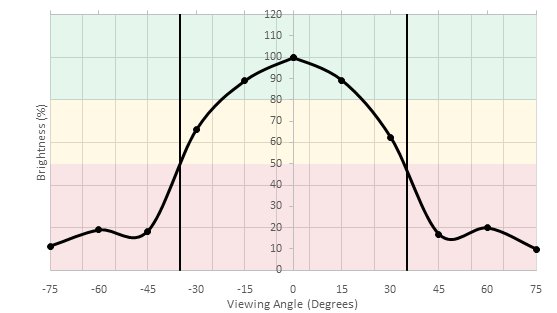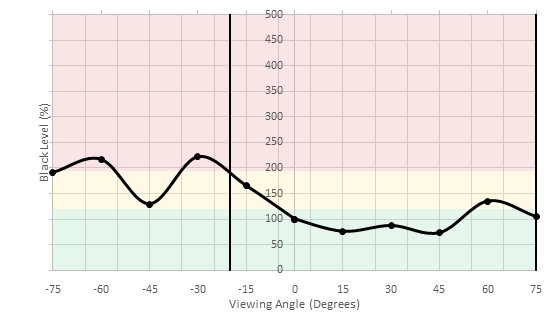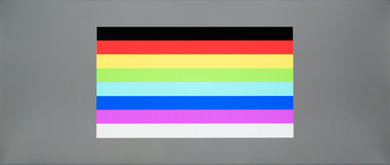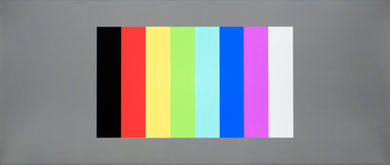The LG 29UM69G is a decent ultrawide IPS gaming monitor with a higher-than-average 75Hz refresh rate. It has great motion handling due to the low response time and ability to flicker the image and clear up fast movement. It also feels responsive due to the low input lag. Unfortunately, the picture quality is below average due to the very poor black uniformity and below-average screen brightness.
Our Verdict
The LG UM69 is an alright monitor overall. The ultrawide resolution is good for multitasking as two windows can fit comfortably side-by-side. The 75Hz refresh rate combined with low input lag and great motion handling make the monitor very responsive. Unfortunately, the picture quality is below average, however, it is accurate out of the box and remains accurate when viewed at an angle.
-
Immersive 21:9 ultrawide aspect ratio.
-
Great motion features such as FreeSync.
-
Mediocre dark room picture quality.
-
Could be brighter.
The LG UM69 is a decent monitor for office use. The ultrawide resolution allows displaying documents or webpages side-by-side and the monitor is accurate out of the box. Unfortunately, the LG 29UM69G can't get very bright to combat glare, but the screen finish is good at reducing reflections. The picture quality is also accurate, which is good, and remains accurate when viewed at an angle which is great for sharing images with coworkers.
The LG UM69 is a good monitor for gaming. It feels responsive due to the low input lag and 75Hz refresh rate, which is good but not as good as other monitors at 120Hz or 144Hz. The motion handling is great but, unfortunately, the picture quality is below average and in a dark room, the black uniformity is very bad.
The LG UM69 is okay for watching movies and TV shows. The picture quality is sub-par due to the low native contrast ratio and poor black uniformity, so blacks appear gray and blotchy. The colors are very accurate out of the box, which is good, and remain accurate when viewed at an angle.
The LG UM69 is okay for editing photos or videos. Unfortunately, the picture quality isn't as good as other monitors and the monitor can't get very bright to overcome glare. The image is very accurate out of the box though, and remains accurate when viewed at an angle. The motion handling is also great.
The LG 29UM69G-B doesn't support HDR, local dimming or a wide color gamut. This is common for most monitors on the market at the moment. For a high-end monitor which supports HDR, see the Samsung CHG70.
- 6.9 Mixed Usage
- 7.0 Office
- 7.5 Gaming
- 6.7 Multimedia
- 6.7 Media Creation
- 4.8 HDR Gaming
Changelog
Check Price
Differences Between Sizes And Variants
We tested the 29" model (29UM69G-B), however, the monitor is also available in a larger 34" size (34UM69G-B).
If someone comes across a different type of panel or if their LG 29UM69G-B doesn't correspond to our review, let us know and we will update the review. Note that some tests such as the gray uniformity may vary between individual units.
| Model | Size | Refresh rate | Notes |
|---|---|---|---|
| 29UM69G-B | 29" | 75Hz | FreeSync support |
| 34UM69G-B | 34" | 75Hz | FreeSync support |
Compared To Other Monitors

The LG 29UM69G is a decent ultrawide monitor and although it has good gaming performance with FreeSync, it is limited by the 75Hz refresh rate. Depending on your budget and specific use, some of the monitors below may be a better choice. See our recommendations for the best 32-inch monitors and the best gaming monitors under $300.
The LG 34UC79G-B is much better than the LG 29UM69G-B. The 34UC79G-B has a larger screen area, and the native refresh rate is much higher, great for use as a gaming monitor. The 34UC79G-B also features two HDMI 2.0 ports, whereas the 29UM69G-B only has 1 HDMI 1.4 port.
The LG 29UM69G-B is somewhat better than the HP V320. The LG 29UM69G-B has marginally better reflection handling, so it is better if you place it in a room with many light sources. The LG also has a better refresh rate and better image flicker, and thus motion looks crisper. Finally, the LG 29UM69G-B has a higher resolution and will display more detail on the screen.
The Samsung CHG70 is a much better monitor for every use than the LG 29UM69G-B. The LG 29UM69G has better viewing angles due to its IPS panel, so it keeps its picture quality when you look from the side. On the other hand, the Samsung CHG70 has better ergonomics, better native contrast ratio, and supports HDR. Finally, the Samsung CHG70 has slightly better input lag and features that make it better for gaming.
The LG 27UD58-B is better than the LG 29UM69G-B. The LG 27UD58-B has a 4K UHD resolution with more detail that makes it easier to multitask, like when you're creating media or watching multimedia while browsing the net. On the other hand, the LG 29UM69G-B has a slightly better refresh rate, a faster pixel response time, and supports black frame insertion (BFI) to clear up blur. All these features are good news for those who plan to use it for video gaming.
The LG 29UM69G-B is somewhat better than the Dell D3218HN. The LG 29UM69G-B has better reflection handling if you have a room with many lights, and has a better resolution that allows you to see more detail on the screen. If you play video games, you will appreciate the better refresh rate of the LG 29UM69G-B. The LG is also equipped with a BFI feature that allows it to introduce flicker and make the image crisper.
The LG 24MP59G-P and LG 29UM69G-B are nearly identical, the 29UM69G is simply a wider version of the 24MP59G. Both monitors have a 75 Hz refresh rate with FreeSync support. The 29UM69G has a faster response time, so fast motion looks better with less motion blur, and the wider screen is slightly better for multitasking.
The BenQ EL2870U and LG 29UM69G-B use different panels, each with their own strengths and weaknesses. The LG uses an IPS panel, which delivers wider viewing angles, and it has a higher native refresh rate. The BenQ has a TN panel, with a much higher resolution 4k screen that is better for multitasking, and it supports HDR, although this doesn't add much.
Test Results
The design of the LG UM69 is good. All of the parts are made of plastic but the monitor is quite stylish with defined edges and glossy plastic. The stand has a small footprint but supports the monitor quite well, although the light weight means the whole monitor moves when knocked. The back is glossy plastic which attracts fingerprints but looks good, and there is a small clip for cable management.
Update 07/02/2021: We previously had incorrectly listed the Height Adjustment as 'N/A' as opposed to '0'. The review has been updated to reflect this change, as the Ergonomics score has dropped slightly.
This LG monitor only has very limited adjustment options, so it may be more difficult to find a comfortable setup. The monitor can only tilt backward.
The rear of the monitor is glossy plastic and looks good, but does attract fingerprints. There is a clip for cable management visible here.
The LG UM69 has a mediocre contrast ratio, which results in blacks that look more gray than really black when viewed in a dark environment. This is mostly normal for IPS monitor. This is not a problem when viewed in an office setting, where there is abundant lighting. If you want a monitor that's better suited for dark rooms, check out the Gigabyte G34WQC.
The LG 29UM69G-B does not have a local dimming feature. The video is for reference only.
The LG UM69 can get decently bright which should be good enough for most rooms, but it may appear a little dim in a very bright room.
The LG UM69 doesn't support HDR.
Good horizontal viewing angle. At an angle, the black level remains nearly perfect, while brightness decreases and colors degrade fairly gradually.
Decent vertical viewing angle. The black level near the bottom of the screen will look a little grayer than at the top of the screen, while the brightness and colors at both the top and bottom of the screen will look a little worse than the center.
Great gray uniformity for this the LG 29UM69G, which is a similar result to the LG 27UD68P-B. This is great for watching content with large uniform areas, such as sports or when browsing the web. Both the right and left side of the screen look a bit darker than the center, but other than this the overall screen is pretty even. On the 5% gray uniformity test picture, not many issues can be noticed at all, which is a great result for watching dark content in a dark room, such as movies at night.
Awful black uniformity for this LG monitor, which is bad for watching dark content in a dark room such as gaming at night. Flashlighting is the major issue here and affects the overall uniformity significantly, especially in the top left corner which can sometimes be noticed even in an average room.
Out of the box, the LG 29UM69G has very good accuracy. The white balance dE is relatively low at 2.11 and the color dE is at 2.93, both of which would be noticeable to professionals. The gamma is at 2.15, which is a bit under what we aim for (2.4), but the curve is not far from our target curve.
This monitor is very accurate and for most people that will not calibrate it, there is more than one 'Picture Mode' that are pretty accurate. 'Custom', 'Photo', 'FPS 1', 'RTS Game', and 'Custom Game' all have similar accuracy, so you could try them and select the one that you find the best for your use.
After calibration, the LG 29UM69G-B is even more accurate. The white balance dE is now only 0.54, which is almost perfect. The color dE went down a bit at 1.85, but not as much as seen on other monitors, but with a color dE of 1.85, it is still pretty good. The gamma was corrected and now track a bit more closely our 2.4 target and the curve sticks a bit more to our target curve.
You can download our ICC profile calibration here.
Excellent color volume. The LG 29UM69G monitor can display its great s.RGB coverage at a range of brightnesses, except at extremely low brightness because of the monitor's mediocre contrast ratio. Its Adobe RGB volume suffers from its limited gamut coverage though.
HDR gamuts are not supported.
HDR color volumes are not supported.
Great performance for the LG 29UM69G on our gradient test. As this picture reveals, besides the 8-bit banding, some little shade issues can be noticed in the darker color, but those are very minor and don't really affect the performance of the monitor while displaying normal content.
Response Time Off
Response Time Slow
Response Time Normal
Response Time Fast
Great response time, good enough for fast-paced content such as playing FPS games or watching sports. Pixel switching speed can be modified by changing the 'Response Time' (Overdrive) setting. We recommend using the 'Normal' setting for fast response with minimal overshoot. Users who don't mind a little more overshoot ghosting may prefer the 'Fast' setting as its overshoot is still tolerable. This will produce a faint inverse image following moving objects though.
Like most monitors, the LG 29UM69G doesn't flicker and shows each image for a full frame. Without flicker, motion appears slightly smoother but persistence blur is more visible due to the static image during each frame. This monitor has an optional BFI setting (1ms Blur Reduction) that greatly reduces persistence blur by adding flicker. Unfortunately, because the flicker is at 75Hz it is quite noticeable at the peripherals of your vision when viewing white windows, which may annoy some users. The monitor's brightness with BFI enabled is the same as its normal brightness, which is great because most monitors are dimmer with BFI.
Update 01/15/2019: We have retested the monitor with NVIDIA's new FreeSync drivers. FreeSync had to be manually enabled in the monitor's OSD and NVIDIA Control Panel, but it worked well, without any noticeable issues.
The LG 29UM69G-B has a good 75Hz refresh rate, which is a bit better than the common 60Hz refresh rate of most monitors but not as good as 144Hz monitors. FreeSync on this monitor can adjust the screen's refresh rate to match the frame rate of a compatible graphics card, which allows playing graphically-intensive games with significant framerate drops without tearing or stuttering; however, the FreeSync range doesn't extend down below 40Hz like many other FreeSync monitors.
Excellent low input lag, partially due to the fast scan time of 75Hz. The only non-native resolution that supports 75Hz is 1920x1080, but it had the same low input lag which is great. The input lag with BFI (1ms Blur Reduction) enabled is much higher but is still fairly low.
The LG 29UM69G-B is an ultrawide monitor with a ~21:9 aspect ratio. Its native resolution is 1080 pixels high but 2560 pixels wide, which is very striking on first impression. This makes it great for putting two windows side by side and for immersive gaming (see our recommendations for the best ultrawide gaming monitors). This resolution and size is better than most 1080p FHD monitors, but not as good as 27" 1440p monitors for most usage because this ultrawide isn't very tall (see our recommendations for the best ultrawide monitors).
Unfortunately, the screen isn't as tall as many 16:9 aspect ratio monitors, but it's tall enough for general usage.
This LG ultrawide monitor supports some extra features like:
- 'Super Resolution' to adjust picture processing
- FreeSync
- Increasing the black level with 'Black Adjust'
- On screen crosshair overlay
- 'Midnight mode' to reduce blue light
- Enable/disable the power LED
Comments
LG 29UM69G-B: Main Discussion
Let us know why you want us to review the product here, or encourage others to vote for this product.









